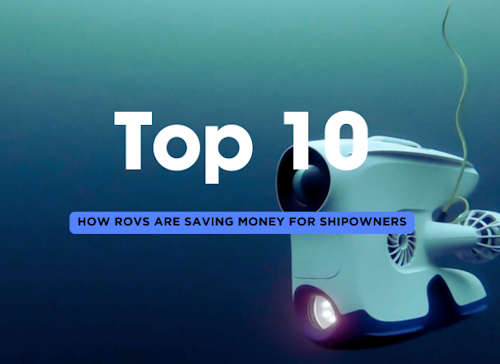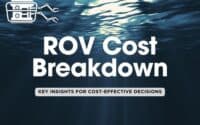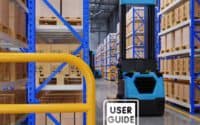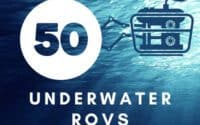Top 10 Ways ROVs are Saving Fleets a lot of Money

Underwater Remotely Operated Vehicles (ROVs) have become essential tools for shipowners looking to streamline inspections, enhance fuel efficiency, and reduce operational costs. From hull inspections to ballast tank monitoring, ROVs allow shipowners to gather real-time data and prevent costly repairs, while improving safety and compliance. In this article, we’ll dive into the Top 10 Reasons Shipowners Should Invest in ROVs, showcasing how these cutting-edge technologies can revolutionize ship management and drive profitability.

1. Hull and Propeller Inspections ⚓
Regular inspections of the hull and propellers are essential for maintaining the ship’s overall efficiency. Hull fouling (marine growth) can increase drag, leading to higher fuel consumption and reduced vessel speed. Traditionally, these inspections required dry-docking or diver inspections, which are both time-consuming and expensive.
Why ROVs Help:
- Cost Savings: ROVs can be deployed while the ship is still in operation, eliminating the need for dry-docking. Dry-docking can cost between $15,000 and $30,000 per day, while ROV inspections can be done for a fraction of the cost.
- Fuel Efficiency: A fouled hull can increase fuel consumption by up to 30%, which for a vessel that consumes 30 tons of fuel per day could mean an extra $6,000 to $9,000 per day. Detecting fouling early using ROVs allows for timely cleaning, saving thousands in fuel costs.
Example:
If a ship uses 30 tons of fuel per day at $600/ton, a 30% increase due to hull fouling would cost an additional $5,400 per day. If an ROV detects fouling early and prevents 30 days of inefficiency, that’s a savings of $162,000.
2. Maintenance and Repair 🔧
Wear and tear on a ship’s structure, including cracks or corrosion, can worsen if not identified early. Traditionally, visual inspections by divers or during dry-docking are used to spot these issues, but by then, they may have already become more costly to repair.
Why ROVs Help:
- Cost Savings: Catching small cracks or corrosion early can prevent major repairs. The average cost to repair structural damage like cracks is around $50,000-$100,000, but if caught early using ROVs, repairs could be as low as $10,000.
- Reduced Downtime: ROVs reduce the need for costly unscheduled maintenance. A ship can lose $20,000 to $50,000 per day in revenue due to downtime for repairs. Using ROVs allows for inspections without taking the ship offline.
Example:
Identifying a small crack early with an ROV could cost $10,000 to fix, while waiting until the crack is larger might cost $100,000 in repairs plus 2 days of downtime at $40,000 per day, totaling $180,000 in losses. The early ROV intervention would save $170,000.
3. Fuel and Performance Optimization ⛽
Marine growth on the hull can significantly increase drag, which in turn raises fuel consumption. Optimizing hull conditions through regular inspections and cleaning can greatly enhance fuel efficiency and overall ship performance.
Why ROVs Help:
- Fuel Cost Reduction: By continuously monitoring the hull’s condition, shipowners can perform cleaning and maintenance exactly when needed, avoiding unnecessary costs. A ship with a poorly maintained hull can consume 30-40% more fuel.
- Cost of Missed Maintenance: If an ROV isn’t used, marine growth that increases fuel usage by 20% can lead to additional costs of around $3,600 per day for a ship using 30 tons of fuel at $600/ton. Missing this over a 30-day voyage means $108,000 in unnecessary fuel costs.
Example:
If an ROV identifies early signs of hull fouling and the ship undergoes cleaning, this could prevent an additional 20% fuel consumption, saving $3,600 per day. Over a 30-day period, this would result in $108,000 in fuel savings.
4. Regulatory Compliance 🌍
Complying with international regulations such as IMO 2020 is crucial for shipowners. These regulations place strict limits on sulfur emissions and ballast water discharge. Non-compliance can lead to significant fines, but keeping up with environmental monitoring manually can be costly and inefficient.
Why ROVs Help:
- Cost Savings: ROVs can be used to monitor compliance with ballast water and emissions regulations. Avoiding fines, which can be as high as $50,000-$100,000 for violations, is crucial for maintaining profitability.
- Automated Reporting: ROVs equipped with sensors can track and document environmental compliance, reducing the need for manual inspections and audits, which can cost $10,000-$30,000 annually per ship.
Example:
If a ship is fined $75,000 for non-compliance with ballast water regulations, using an ROV to monitor and document compliance could prevent this fine. Over time, automated compliance reporting via ROVs could save $100,000 or more across multiple ships.
💡 Find the right ROV for your needs—request quotes now!
5. Emergency Inspections After Groundings or Collisions 🚨
Accidents happen, and when they do, time is of the essence. After a grounding or collision, assessing underwater damage quickly is vital. Traditionally, divers are deployed, which takes time and puts them at risk, while waiting for dry-docking is even more costly.
Why ROVs Help:
- Rapid Response: ROVs can be deployed immediately following an incident, providing real-time visuals of the damage without waiting for divers or dry-docking. This rapid assessment helps shipowners make faster decisions on repairs or insurance claims.
- Cost Savings: Emergency repairs after groundings can range from $200,000 to $500,000 depending on the severity. Using an ROV can lead to earlier detection and smaller repairs, reducing these costs by 10-20%.
- Reduced Downtime: Immediate ROV deployment can minimize downtime by diagnosing problems quicker. Saving even one day of downtime (typically $20,000-$50,000 per day in revenue loss) can cover the cost of the ROV itself.
Example:
If an ROV detects damage early and repairs cost $300,000, versus a delayed inspection leading to more significant repairs costing $400,000, that’s a $100,000 saving. Immediate response could also save $50,000 in lost revenue from downtime.
6. Surveys for Salvage Operations 🛠️
In the event of cargo falling overboard or equipment malfunctioning underwater, an ROV can quickly locate and help recover lost items. Salvage operations can be extremely expensive and time-consuming when relying on divers or full-blown recovery efforts.
Why ROVs Help:
- Cost Savings: Hiring a diver team or heavy-duty salvage operations can cost $50,000-$100,000 per day. An ROV can locate lost cargo or equipment in less time and at a fraction of the cost.
- Efficiency: ROVs can operate in deeper and more hazardous environments than divers, ensuring a quicker, safer, and often more successful recovery operation.
- Asset Recovery: Recovering lost cargo or equipment worth $500,000 using an ROV might only cost $10,000-$20,000, compared to much higher costs for traditional salvage.
Example:
If a ship loses cargo valued at $600,000, an ROV could locate and facilitate the recovery for $15,000, versus $100,000 in traditional salvage costs. This represents a $85,000 savings, plus the recovery of high-value assets.
7. Cost-Effectiveness and ROI 💸
Investing in underwater ROVs can seem like a large upfront expense, but the long-term savings in reduced downtime, fuel efficiency, and maintenance costs make the investment worthwhile. For shipowners, calculating the return on investment (ROI) of ROVs is crucial.
Why ROVs Help:
- Cost Savings: With reduced need for dry-docking, divers, and early detection of issues, ROVs can save shipowners hundreds of thousands annually. A typical ROV unit may cost $20,000-$100,000, but it can save up to $200,000 per year in maintenance and fuel costs.
- Rapid ROI: Depending on usage, the return on investment can be achieved in as little as 1-2 years through cost reductions in inspections, fuel savings, and reduced downtime.
Example:
An ROV system costing $50,000 that saves $100,000 annually from fuel efficiency improvements and reduced maintenance costs can deliver a full ROI within the first year of operation, with every subsequent year adding savings to the bottom line.
8. Inspection of Ballast Tanks 🛢️
Ballast tanks are difficult to inspect manually due to their confined spaces, yet they are critical to a ship’s stability and overall safety. Traditionally, these inspections are labor-intensive and time-consuming, often requiring manual entry or dry-docking.
Why ROVs Help:
- Cost Savings: Inspecting ballast tanks with an ROV can save $30,000-$50,000 per inspection by eliminating the need for dry-docking or manual labor.
- Increased Safety: ROVs can access confined spaces without putting crew members at risk, ensuring safer operations.
- Compliance: Regular inspections of ballast tanks are required for compliance with international regulations. Using an ROV ensures these inspections are done quickly and accurately.
Example:
If a ship requires two ballast tank inspections annually, and each manual inspection costs $40,000, switching to ROV inspections costing $10,000 can save $60,000 per year.
💡 Top ROV suppliers, one form—get your quotes now!
9. Reducing Risk to Human Divers 🤿
Using divers to inspect a ship’s underwater areas can be dangerous, especially in harsh environments or following incidents like groundings or collisions. Shipowners are increasingly looking for safer, more efficient alternatives.
Why ROVs Help:
- Cost Savings: Diver operations can cost $20,000-$50,000 per day, depending on the complexity of the job and location. ROVs can perform the same tasks at a fraction of the cost and without risking human lives.
- Safety: ROVs reduce the need for divers in dangerous situations, such as strong currents, murky waters, or hazardous conditions. This minimizes the risk of injury and associated insurance claims.
Example:
A typical diver-led inspection after a collision could cost $50,000 and put divers at risk. Using an ROV that costs $10,000 for the same job could save $40,000 while eliminating the risk to human divers.
10. Monitoring of Mooring Systems and Anchors ⚓
Mooring systems and anchors are critical components of a ship’s safety, especially when docked or during rough weather. Over time, wear and tear can compromise their integrity, leading to potential accidents or costly repairs if not properly monitored.
Why ROVs Help:
- Cost Savings: ROVs can perform regular inspections of mooring systems and anchors, reducing the risk of failure. Repairing a damaged anchor or mooring system could cost $100,000 or more, while proactive ROV inspections may cost $5,000-$10,000.
- Preventing Accidents: A damaged mooring system can lead to the vessel drifting, causing potential collisions or grounding. Preventive ROV inspections can help detect weaknesses early, preventing costly accidents.
Example:
If an ROV detects damage to an anchor chain that could lead to a mooring system failure, repairs costing $10,000 may prevent an incident that would result in damages of $100,000 or more.
The implementation of underwater ROVs provides shipowners with a powerful tool to enhance operational efficiency, reduce maintenance costs, improve safety, and ensure compliance. From optimizing fuel consumption and monitoring the hull to inspecting mooring systems and ballast tanks, ROVs offer a proactive and cost-effective solution to prevent costly repairs and downtime. By addressing these top concerns, ROVs enable shipowners to protect their vessels and increase profitability while minimizing risks and environmental impacts.
Table Summary
| ShipUniverse: Top 10 Reasons to Use ROVs for Ship Inspections and Maintenance | |
| Reason | Benefit |
| 1. Hull and Propeller Inspections | Spot marine growth early, avoid dry-docking, and save up to $162,000 per year by preventing fuel inefficiencies. |
| 2. Maintenance and Repair | Detect cracks or corrosion early, saving $170,000 in costly repairs and avoiding extended downtime. |
| 3. Fuel Efficiency Optimization | Monitor hull conditions and marine growth, potentially saving $108,000 in fuel over a 30-day voyage. |
| 4. Regulatory Compliance and Environmental Monitoring | Prevent non-compliance fines of up to $75,000 and save over $100,000 through automated compliance reporting. |
| 5. Emergency Inspections After Groundings or Collisions | Deploy ROVs quickly after incidents, saving $100,000 in repair costs and $50,000 in downtime avoidance. |
| 6. Salvage Operations and Asset Recovery | Quickly locate and recover lost cargo, saving up to $85,000 on traditional salvage costs. |
| 7. Cost-Effectiveness and ROI | Achieve full ROI in 1-2 years by saving $100,000 annually through inspections, fuel savings, and reduced repairs. |
| 8. Ballast Tank and Internal Structure Inspections | Save $60,000 annually on ballast tank inspections by replacing manual checks with ROV assessments. |
| 9. Reducing Risk to Human Divers | Avoid diver-led inspections that can cost $50,000 per day, saving $40,000 per inspection while eliminating safety risks. |
| 10. Monitoring Mooring Systems and Anchors | Identify anchor or mooring damage early, preventing incidents that could cost $100,000 or more in repairs. |

Do you have a Maritime Product or Service that may be of interest to Shipowners? Tell us about it here!
Do you have feedback or insights? Please reach out to editor @ shipuniverse.com



